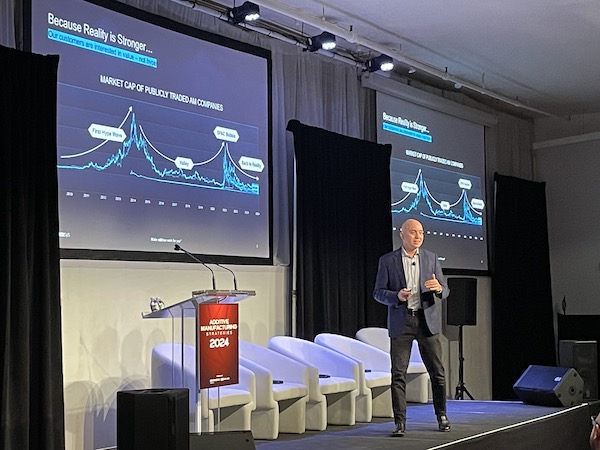An Industry Reckoning at Additive Manufacturing Strategies
Leaders urge consolidation as financial difficulties pile up.

Stratasys CEO YoavYoav Zeif addresses the crowd at Additive Manufacturing Strategies in New York.
Latest News
February 12, 2024
Executives from the 3D printing industry gathered at the annual Additive Manufacturing Strategies conference in New York Feb. 6-8 to discuss the state of the industry and hear presentations from leading end users and their peers.
After a year that saw major vendors in the space struggle to maintain revenues and share prices, the mood among attendees was somewhat subdued. The keynote speakers emphasized the need for the industry to reflect and reorganize around its strengths, and face up to the need for additional industry consolidation.
This was hammered home even more by the selection of the keynote speakers for the first two days, who have been involved in a rancorous takeover bid for the past year. In what organizers described as a Tale of Two Yoavs, the conference featured presentations by Stratasys CEO Yoav Zeif and Nano Dimension CEO Yoav Stern.
Stratasys has been fending off a takeover bid from Nano Dimension (its largest shareholder) for more than a year. Nano scuttled a proposed merger between Stratasys and Desktop Metal, and a similar bid for Stratasys from 3D Systems also failed. At the same time, revenues and venture capital funding are drying up for many companies, and share prices for the public companies in the space have been falling.
Stratasys Zeif, in his keynote, described the industry as depressed, and said current conditions have forced companies to face reality.
“How do we do it? By really aligning our standards. Second, by delivering full solutions tailored to an application or use case. And the third one is, we need to consolidate. When we compare ourselves to other industries, we are too stretched.”
He said that the industry is growing gradually, but there are too many niche vendors to remain sustainable. The solution is focus, he said. “We don’t need to try to reduce the cost of a Toyota Corolla by a few dollars. What we do need to do is focus on things that only additive can deliver.”
Those things include creating complex geometries that no one else can produce; providing more sustainable alternatives to other manufacturing processes; and reducing risk in the supply chain.
“[Our industry] is a gift to anyone on earth who is doing low-volume, high-mix, high-value production,” he said. “We can provide mass customization and precision manufacturing. We can be a $566 billion industry just by addressing those applications.”
While Zeif was not specific in his call for consolidation, Nano Dimension CEO Stern was much more blunt, referencing the ongoing Stratasys drama and calling out specific companies for their poor financial performance. He said that while the industry is not going away, many additive companies may be absorbed or go out of business because “Nobody is profitable.”
Stern said that companies need to focus on the profitable parts of their business and improve their gross margins in order to invest in development.
“We need to get over our egos,” he said. “You are not worth billions. You are worth what you're worth. Egos have a funny way of disappearing when you don’t have enough cash, but this industry has skipped this stage. People have no cash and their egos are still going.”
“The industry needs to grow up,” he added.
Other speakers emphasized the need for open software platforms that can help design capabilities catch up with the potential of the hardware.
In another session, Additive Manufacturing Research executive VP of research Scott Dunham noted that additive manufacturing services are the largest part of the market when considered together. While growth has leveled off, he noted that specialization will drive growth moving forward.
Industry veteran Tuan TranPham, who led a panel discussion on services, noted that customers are focused on product quality and cost, not processes or brand names. “If you listen to the customer, they do not care which machine or technology you use, or which brand. They don't care about any of that.”
Materialise CEO Brigitte de Vet-Veithen was a bit more optimistic than her colleagues at Stratasys and Nano Dimension, but also noted the importance of focusing on end-to-end applications where additive provides value while ensuring part quality and efficiency.
“On the software side we need collaboration, not necessarily consolidation,” she said. ”The industry cannot afford to maintain 100 different platforms and ecosystems. We are too small for that.”
More Materialise Coverage
More Stratasys Coverage
Subscribe to our FREE magazine, FREE email newsletters or both!
Latest News
About the Author
Brian Albright is the editorial director of Digital Engineering. Contact him at [email protected].
Follow DE





